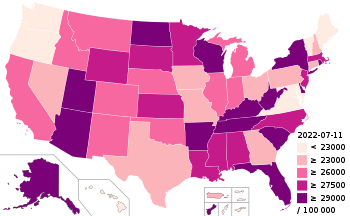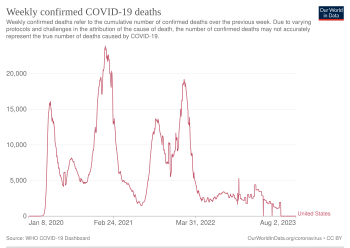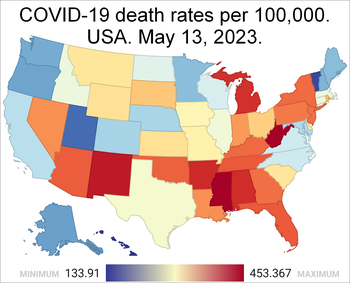
Back جائحة فيروس كورونا في الولايات المتحدة Arabic ABŞ-də COVID-19 pandemiyası Azerbaijani Распаўсюджванне COVID-19 у ЗША Byelorussian Пандемия от COVID-19 в САЩ Bulgarian अमेरिका में कोविड-19 महामारी Bihari যুক্তরাষ্ট্রে কোভিড-১৯ এর বৈশ্বিক মহামারী Bengali/Bangla پەتای جیھانیی کۆڤید-١٩ لە ئەمریکا CKB Pandemie covidu-19 ve Spojených státech amerických Czech COVID-19-Pandemie in den Vereinigten Staaten German Πανδημία COVID-19 στις ΗΠΑ Greek
| COVID-19 pandemic in the United States | |
|---|---|
 COVID-19 cases per 100,000 people by state, as of July 11, 2022 | |
| Disease | COVID-19 |
| Virus strain | SARS-CoV-2 |
| Location | United States |
| First outbreak | Wuhan, Hubei, China[1] |
| Arrival date | January 13, 2020[2] (5 years, 2 weeks and 1 day ago) Public health emergency: January 31, 2020 – May 11, 2023 (3 years, 3 months, 1 week and 4 days) |
| Confirmed cases | 103,436,829[3] |
| Suspected cases‡ | 146,585,169 (CDC estimate in September 2021)[4] |
| Recovered |
|
Deaths |
|
| Fatality rate | 1.17% |
| Vaccinations | |
| Government website | |
| CDC | |
| ‡Suspected cases have not been confirmed by laboratory tests as being due to this strain, although some other strains may have been ruled out. | |


On December 31, 2019, China announced the discovery of a cluster of pneumonia cases in Wuhan. The first American case was reported on January 20,[9] and Health and Human Services Secretary Alex Azar declared a public health emergency on January 31.[10] Restrictions were placed on flights arriving from China,[11][12] but the initial U.S. response to the pandemic was otherwise slow in terms of preparing the healthcare system, stopping other travel, and testing.[13][14][15][a][17] The first known American deaths occurred in February[18] and in late February President Donald Trump proposed allocating $2.5 billion to fight the outbreak. Instead, Congress approved $8.3 billion with only Senator Rand Paul and two House representatives (Andy Biggs and Ken Buck) voting against, and Trump signed the bill, the Coronavirus Preparedness and Response Supplemental Appropriations Act, 2020, on March 6.[19] Trump declared a national emergency on March 13.[20] The government also purchased large quantities of medical equipment, invoking the Defense Production Act of 1950 to assist.[21] By mid-April, disaster declarations were made by all states and territories as they all had increasing cases. A second wave of infections began in June, following relaxed restrictions in several states, leading to daily cases surpassing 60,000. By mid-October, a third surge of cases began; there were over 200,000 new daily cases during parts of December 2020 and January 2021.[22][23]
COVID-19 vaccines became available in December 2020, under emergency use, beginning the national vaccination program, with the first vaccine officially approved by the Food and Drug Administration (FDA) on August 23, 2021.[24] Studies have shown them to be highly protective against severe illness, hospitalization, and death. In comparison with fully vaccinated people, the CDC found that those who were unvaccinated were from 5 to nearly 30 times more likely to become either infected or hospitalized. There has nonetheless been some vaccine hesitancy for various reasons, although side effects are rare.[25][26] There were also numerous reports that unvaccinated COVID-19 patients strained the capacity of hospitals throughout the country, forcing many to turn away patients with life-threatening diseases.
A fourth rise in infections began in March 2021 amidst the rise of the Alpha variant, a more easily transmissible variant first detected in the United Kingdom. That was followed by a rise of the Delta variant, an even more infectious mutation first detected in India, leading to increased efforts to ensure safety. The January 2022 emergence of the Omicron variant, which was first discovered in South Africa, led to record highs in hospitalizations and cases in early 2022, with as many as 1.5 million new infections reported in a single day.[27] By the end of 2022, an estimated 77.5% of Americans had had COVID-19 at least once, according to the CDC.[28]
State and local responses to the pandemic during the public health emergency included the requirement to wear a face mask in specified situations (mask mandates), prohibition and cancellation of large-scale gatherings (including festivals and sporting events), stay-at-home orders, and school closures.[29] Disproportionate numbers of cases were observed among Black and Latino populations,[30][31][32] as well as elevated levels of vaccine hesitancy,[33][34] and there was a sharp increase in reported incidents of xenophobia and racism against Asian Americans.[35][36] Clusters of infections and deaths occurred in many areas.[b] The COVID-19 pandemic also saw the emergence of misinformation and conspiracy theories,[39] and highlighted weaknesses in the U.S. public health system.[17][40][41]
In the United States, there have been 103,436,829[3] confirmed cases of COVID-19 with 1,212,060[3] confirmed deaths, the most of any country, and the 17th highest per capita worldwide.[42] The COVID-19 pandemic ranks as the deadliest disaster in the country's history.[43] It was the third-leading cause of death in the U.S. in 2020, behind heart disease and cancer.[44] From 2019 to 2020, U.S. life expectancy dropped by three years for Hispanic and Latino Americans, 2.9 years for African Americans, and 1.2 years for White Americans.[45] In 2021, U.S. deaths due to COVID-19 rose,[46] and life expectancy fell.[47]
- ^ Sheikh K, Rabin RC (March 10, 2020). "The Coronavirus: What Scientists Have Learned So Far". The New York Times. Retrieved March 24, 2020.
- ^ "Second Travel-related Case of 2019 Novel Coronavirus Detected in United States". U.S. Centers for Disease Control and Prevention (CDC).
Second Travel-related Case of 2019 Novel Coronavirus Detected in United States: The patient returned to the U.S. from Wuhan on January 13, 2020
- ^ a b c d e f Mathieu E, Ritchie H, Rodés-Guirao L, Appel C, Giattino C, Hasell J, et al. (2020–2024). "Coronavirus Pandemic (COVID-19)". Our World in Data. Retrieved January 21, 2025.
- ^ "Estimated COVID-19 Burden". U.S. Centers for Disease Control and Prevention (CDC). July 27, 2021.
- ^ "U.S. recovered COVID-19 cases". Worldometer. Frequently updated.
- ^ "COVID Data Tracker". CDC. U.S. Centers for Disease Control and Prevention (CDC). August 10, 2024. Retrieved August 18, 2024.
- ^ "The pandemic's true death toll". The Economist. January 25, 2022. Archived from the original on February 8, 2024. Retrieved January 25, 2022.
- ^ COVID-19 Deaths per 100K. U.S. News & World Report. Run your cursor over the map to see the dates and data for each state. "The data on this page is courtesy of USAFacts – a nonprofit, nonpartisan civic initiative – and includes information from the Centers for Disease Control and Prevention and state and local health departments. See a detailed methodology at the USAFacts website."
- ^ Holshue ML, DeBolt C, Lindquist S, Lofy KH, Wiesman J, Bruce H, et al. (March 5, 2020). "First Case of 2019 Novel Coronavirus in the United States". New England Journal of Medicine. 382 (10): 929–936. doi:10.1056/NEJMoa2001191. ISSN 0028-4793. PMC 7092802. PMID 32004427.
- ^ "Proclamation on Declaring a National Emergency Concerning the Novel Coronavirus Disease (COVID-19) Outbreak". The White House. March 13, 2020.
- ^ Aubrey A (January 31, 2020). "Trump Declares Coronavirus A Public Health Emergency And Restricts Travel From China". NPR. Retrieved March 18, 2020.
'Foreign nationals other than immediate family of U.S. citizens and permanent residents who have traveled in China in the last 14 days will be denied entry into United States,' Azar said.
- ^ Robertson L (April 15, 2020). "Trump's Snowballing China Travel Claim". FactCheck.org. Retrieved April 29, 2020.
... effective February 2.
- ^ Lemire J, Miller Z, Colvin J, Alonso-Zaldivar R (April 12, 2020). "Signs missed and steps slowed in Trump's pandemic response". Associated Press. Retrieved April 28, 2020.
- ^ Pilkington E, McCarthy T (March 28, 2020). "The missing six weeks: how Trump failed the biggest test of his life". The Guardian. ISSN 0261-3077. Retrieved March 28, 2020.
- ^ Ollstein AM (April 14, 2020). "Trump halts funding to World Health Organization". Politico. ISSN 2381-1595. Wikidata Q104180080. Retrieved April 28, 2020.
- ^ Whoriskey P, Satija N (March 16, 2020). "How U.S. coronavirus testing stalled: Flawed tests, red tape and resistance to using the millions of tests produced by the WHO". The Washington Post. Retrieved March 18, 2020.
- ^ a b Banco E. "Inside America's Covid-reporting breakdown". Politico. Retrieved May 9, 2022.
- ^ https://www.npr.org/sections/coronavirus-live-updates/2020/04/22/840836618/1st-known-u-s-covid-19-death-was-on-feb-6-a-post-mortem-test-reveals [bare URL]
- ^ "Trump signs $8.3B bill to combat coronavirus outbreak in US". AP News. March 6, 2020.
- ^ "COVID-19 Emergency Declaration | FEMA.gov". www.fema.gov. March 14, 2020.
- ^ Watson K (March 27, 2020). "Trump invokes Defense Production Act to require GM to produce ventilators". CBS News. Retrieved April 24, 2020.
- ^ "COVID-19 Cases Are Skyrocketing, But Deaths Are Flat – So Far. These 5 Charts Explain Why". Time. Retrieved February 25, 2021.
- ^ "COVID Data Tracker". U.S. Centers for Disease Control and Prevention (CDC). March 28, 2020. Retrieved September 21, 2021.
- ^ FDA Approves First COVID-19 Vaccine. U.S. Food and Drug Administration (FDA). August 23, 2021. Retrieved October 16, 2021.
- ^ "Fauci: Polio would still exist in US if 'false information' being spread now existed decades ago", ABC News, July 20, 2021
- ^ Stieg C (July 6, 2021). "Dr. Fauci: Where to expect new Covid surges in the U.S.—and what it means for mask-wearing, other restrictions". CNBC. Retrieved July 11, 2021.
- ^ Rattner N (January 11, 2022). "U.S. sets fresh records for Covid hospitalizations and cases with 1.5 million new infections". CNBC. Retrieved January 12, 2022.
- ^ Vlachou M (July 4, 2023). "CDC Estimates How Many Americans Hadn't Had COVID By End Of 2022". HuffPost. Retrieved July 4, 2023.
- ^ Deb S, Cacciola S, Stein M (March 11, 2020). "Sports Leagues Bar Fans and Cancel Games Amid Coronavirus Outbreak". The New York Times. ISSN 0362-4331. Archived from the original on March 11, 2020. Retrieved March 12, 2020.
- ^ Godoy M (May 30, 2020). "What Do Coronavirus Racial Disparities Look Like State By State?". NPR.
- ^ Karson K, Scanlan Q (May 22, 2020). "Black Americans and Latinos nearly 3 times as likely to know someone who died of COVID-19: Poll". ABC News.
- ^ "States tracking COVID-19 race and ethnicity data". American Medical Association. July 28, 2020. Retrieved July 31, 2020.
- ^ Beleche T, et al. (May 2021). "COVID-19 Vaccine Hesitancy: Demographic Factors, Geographic Patterns, and Changes Over Time" (PDF). Assistant Secretary for Planning and Evaluation, US HHS. Retrieved August 9, 2021.
- ^ Livingston C (April 8, 2021). "Black Americans' Vaccine Hesitancy is Grounded in More Than Mistrust". Duke University. Retrieved August 9, 2021.
- ^ "New report finds 169 percent surge in anti-Asian hate crimes during the first quarter". NBC News. April 28, 2021. Retrieved December 27, 2021.
- ^ Tavernise S, Oppel RA Jr (March 23, 2020). "Spit On, Yelled At, Attacked: Chinese-Americans Fear for Their Safety". The New York Times. Archived from the original on March 23, 2020. Retrieved March 23, 2020.
- ^ "COVID-19 Infections And Deaths Are Higher Among Those With Intellectual Disabilities". NPR.
- ^ "U.S. Navy Policies Battling COVID-19 Rely Heavily On Isolation". NPR.
- ^ Douglas KM (February 2021). "COVID-19 conspiracy theories". Group Processes & Intergroup Relations. 24 (2): 270–275. doi:10.1177/1368430220982068. ISSN 1368-4302. S2CID 232132806.
- ^ Butcher L (November 17, 2020). "Pandemic puts all eyes on public health". Knowable Magazine. doi:10.1146/knowable-111720-1. Retrieved March 2, 2022.
- ^ Nuwer R (June 13, 2022). "Universal Health Care Could Have Saved More Than 330,000 U.S. Lives during COVID". Scientific American. Retrieved June 22, 2022.
- ^ "Mortality Analyses". Johns Hopkins University. Retrieved December 17, 2020.
- ^ "COVID-19 surpasses 1918 flu as deadliest pandemic in U.S. history". National Geographic. September 21, 2021.
- ^ Stobbe M (December 21, 2020). "US deaths in 2020 top 3 million, by far most ever counted". Associated Press.
- ^ Bosman J, Kasakove S, Victor D (July 21, 2021). "U.S. Life Expectancy Plunged in 2020, Especially for Black and Hispanic Americans". The New York Times. Archived from the original on December 28, 2021. Retrieved July 21, 2021.
- ^ Shapiro E, Pereira I, Deliso M (October 6, 2021). "COVID-19 live updates: More Americans died of COVID this year than all of 2020". ABC News. Retrieved October 6, 2021.
- ^ Bernstein L (December 22, 2022). "U.S. life expectancy continued to fall in 2021 as covid, drug deaths surged". The Washington Post. Retrieved December 22, 2022.
Cite error: There are <ref group=lower-alpha> tags or {{efn}} templates on this page, but the references will not show without a {{reflist|group=lower-alpha}} template or {{notelist}} template (see the help page).